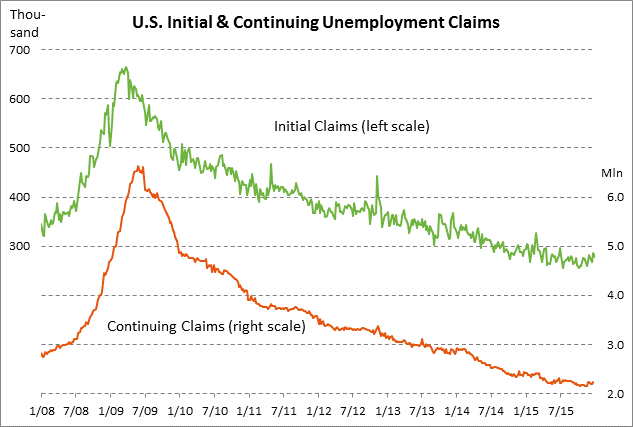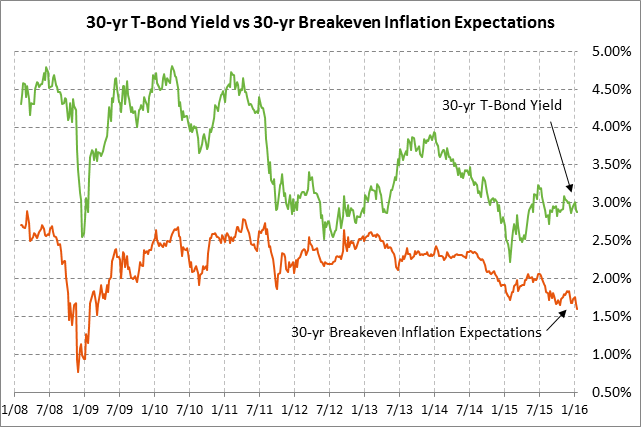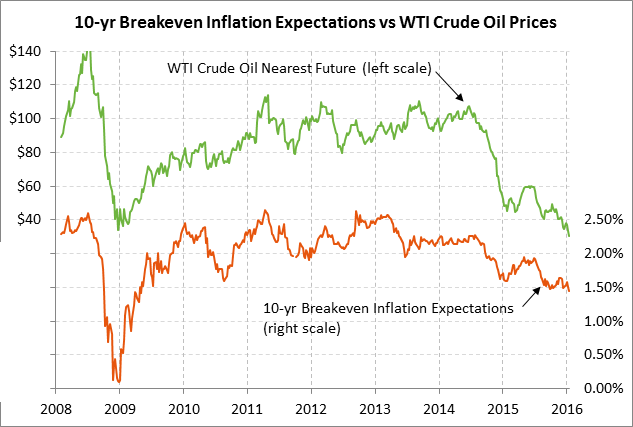- Initial unemployment claims remain elevated due to holiday distortions
- U.S. import prices expected to show another weak report and keep downward pressure on overall U.S. inflation rate
- 30-year T-bond auction to yield near 2.88%
- U.S. inflation expectations continue to closely track oil prices and fall to 3-month low
Initial unemployment claims remain elevated due to holiday distortions –– The initial unemployment claims series is a bit elevated, but not by enough to cause any concern about the labor market, particularly because the claims data is being affected by holiday distortions. The initial claims series posted a 6-month high of 287,000 in the week ended Dec 25 but then fell in last week’s report for the week ended Jan 1 by +10,000 to 277,000. The initial claims series is moderately above the 42-year low of 255,000 posted in July 2015 by +22,000. Meanwhile, the continuing claims series is +84,000 above its 15-year low of 2.146 million posted in Oct 2015.
The market is expecting today’s initial claims report to show a slight decline of -2,000 to 275,000, adding to last week’s decline of -10,000. The market is expecting today’s continuing claims report to show a -20,000 decline to 2.210 million, reversing most of last week’s +25,000 increase to 2.230 million.
On the labor front, the markets were impressed by last Friday’s strong Dec payroll report of +292,000 and the +41,000 upward revision for Nov to 252,000. Payrolls in the last three reporting months of Oct-Dec showed a strong monthly average increase of +284,000. In addition, the Dec unemployment rate was unchanged at the 8-year low of 5.0% posted in Oct-Nov. The unemployment rate must fall by only another -0.3 points before it hits the FOMC’s mid-point forecast of 4.7% for the unemployment rate in 2016-18, meaning that the unemployment rate has nearly met one of the FOMC’s key labor market targets.
Despite the strength in the labor market in the last three months of 2015, the markets are currently worried about whether some businesses will be getting cold feet about hiring in 2016 due to the shaky start to the new year with the Chinese turmoil and the downward correction in the U.S. stock market.
U.S. import prices expected to show another weak report and keep downward pressure on overall U.S. inflation rate — The market is expecting today’s Dec import price index report to show a large decline of -1.4% m/m, adding to Nov’s -0.4% decline. On a year-on-year basis, U.S. import prices are expected to improve mildly to -8.4% y/y from -9.4% in Nov.
The weakness in import prices is partially due to the plunge in oil prices. However, there is weakness across the board in import prices with U.S. import prices ex-petroleum down -3.4% y/y in November. Import prices are generally seeing weakness due to lackluster domestic demand, falling commodity prices in general, and the strong dollar, which allows importers to cut prices since they are being paid in more valuable dollars.
The weakness in import prices is helping to dampen the overall U.S. inflation outlook. The U.S. core PCE deflator in November of +1.3% y/y was well below the Fed’s +2.0% inflation target and remained at the 4-1/2 year low seen all this year. There is no sign at present of any upward momentum in core inflation.
30-year T-bond auction to yield near 2.88% — The Treasury today will conclude this week’s $58 billion coupon package by selling $13 billion of 30-year T-bonds. Today’s auction will be the second and last reopening of the 3.00% 30-year bond of November 2045 that the Treasury first sold in November.
Today’s 30-year T-bond issue was quoted at 2.88% in when-issued trading yesterday afternoon. That translates to an inflation-adjusted yield of 1.28% against the current 30-year breakeven inflation expectations rate of 1.60%.
The 12-auction averages for the 30-year are as follows: 2.33 bid cover ratio, $10 million in non-competitive bids to mostly retail investors, 5.2 bp tail to the median yield, 14.1 bp tail to the low yield, and 54.5% taken at the high yield. The 30-year is slightly below average in popularity among foreign investors and central banks. Indirect bidders, a proxy for foreign buyers, have taken an average of 54.5% of the last twelve 30-year T-bond auctions, slightly below the average of 54.7% for all recent Treasury coupon auctions.
U.S. inflation expectations continue to closely track oil prices and fall to 3-month low — The U.S. 10-year breakeven inflation expectations rate yesterday fell to a new 3-month low of 1.43% and closed the day at 1.44%. That rate is now only 6 bp above 6-2/3 year low of 1.38% posted in September 2015.
The plunge in oil prices has been the major factor pulling inflation expectations lower with Feb WTI crude oil futures on Tuesday posted a new 12-year low. The 52-week rolling correlation between the 10-year inflation expectations rate and oil prices has risen to a strong 0.50 at present from no correlation before the oil price plunge started in autumn-2014. The decline in inflation expectations has been a major supportive factor for the T-note market. However, inflation expectations have also been driven lower by weak commodity prices in general and by weak global economic demand.



